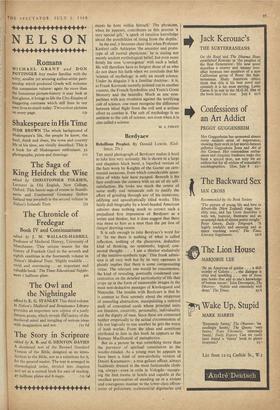Beautiful Healer
Asklepios. By C. Kerdnyi. (Thames and Hudson, 30s.).
IT has become a commonplace to point out how much Freud contributed to the preoccupation with myth which saturates contemporary culture. Myths, like dreams, express in symbolic language man's innermost fears, anxieties, lusts and hopes. In the study of myth, Professor Kerenyi explained in a 'self-assessment' written ten years ago, one must adopt the 'axiom' of depth psychology, namely, that 'it contains not one idea, not one word, no picture and no combination, whether in man's waking state or in his dreams, which is meaningless, which is nonsense, an action gratuite of the human spirit.'
Professor Kerenyi is of course closer to Jung than to Freud. The present book, however, 'is not an attempt to apply the methods of Jungian psychology.' The use of the word 'archetypal' serves solely to 'stress the possibility of conver- gence with modern psychology.' Notably the reader will find little here in the way of system- atic analysis of symbols. Thus, the most common symbol associated with Asklepios is the snake—
still surviving in the caduceus—but the author is not interested in the phallic symbolism of the snake and barely mentions it. I do not mean that he rejects such an interpretation, but that he ignores it, and that raises a fundamental question. Naïvely one might assume that a 'science of mythology' would involve some sort of rational analysis. Professor Kerenyi's erudition is, in fact, enormous. He has read everything and examined all the available figured monuments as well. Much of this little book is highly technical (and com- petent) in its discussion of the philological and archaeological evidence for the Asklepios myths and cults. That side of the work may be called rational. But what has been accomplished? The
reader will come away with many facts about the main centres of the cult and the complicated mythology connected with it. But what will he understand? What, in other words, will he have gained from Professor Kerenyi's application of his 'axiom' (which, incidentally, I accept)? Will he have seen the sense in what is asserted never to be nonsense?
Jane Harrison once referred to the 'strange web of human chicanery that was woven round the dream cure.' Though that is not a sufficient ex- planation—and she never pretended that it was— it is'surely a part of the story. But it is not part of Professor Kerenyi's story. Jane Harrison's name does not appear among the two hundred entries in his bibliography. Nor does Ernst Cassirer or Professor Dodds. The latter's The Greeks and the Irrational was written to remind us that Hellenic civilisation also contained irrational elements. One of them was the dream cure, which persisted and even grew in popularity in the face of ad- vancing medical science. The Hippocratics were at one and the same time 'descendants of Askle- pios' and opponents of the irrationalism of the Asklepios cult. It is the sense of this ambivalence, the sense—a limited one—in which the dream cure was neither nonsense nor chicanery, which a science of mythology might help elucidate. When Professor Kerenyi does not evade such questions altogether, he offers nothing but dogmatic and oracular pronouncements.
'The vision of the beautiful young healer appearing while the patient's toe is being cured by the snake is a kind of dream within a dream, an amplification reaching out for a still deeper meaning—the immediate experience of the div- ine in the natural miracle of healing.' At the Asklepieion the 'patient himself was offered an opportunity to bring about the cure whose ele- ments he bore within himself.' The physician, when he appears, contributes to this process 'a very special gift,' a spark of intuitive knowledge about the possibilities of rising from the depths.'
In the end, it becomes clear that when Professor Kerenyi calls Asklepios 'the ancestor and proto- type of all 'mortal physicians,' he is stating not merely ancient mythological belief, but even more firmly his own 'convergence' with such a belief. He will therefore have to forgive those of us who do not share his faith when we conclude that his 'science of mythology' is only an occult science. Under its disguise is is a familiar doctrine : it is, as Frank Kermode recently pointed out in another context, the French Symbolists and Yeats's Great Memory and the beatniks. Much as one sym- pathises with any revulsion against the terrifying cult of science, one must recognise the difference between blind flight from the evil and a serious effort to combat it. The cult of mythology is no antidote to the cult of science, not even when it is also called a science.
M. I. FINLEY



























































 Previous page
Previous page